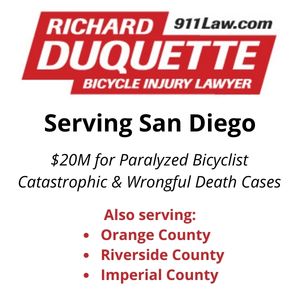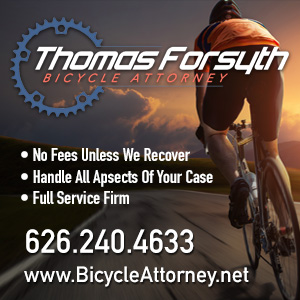It’s been awhile since we’ve heard from St. Louis correspondent Karen Karabell.
While I don’t always agree with her, I’ve found Karen to be one of the most agreeable people to disagree with I’ve ever encountered. In fact, she’s become one of my favorite people, even if we’ve never managed to close the 1,800 some odd miles separating us.
I do agree that knowing how to ride anywhere, under any circumstances, makes all the difference in both your safety on the streets, and your enjoyment on your bike. And taking a course in bike safety is one of the the fastest and best ways to get there.
……..
The news this summer from Southern California has been thrilling. Three cycling clubs have offered CyclingSavvy to their members. Big Orange is considering making participation in a CyclingSavvy workshop mandatory for membership.
Wow! Before we know it, cyclists everywhere will recognize CyclingSavvy as a quantum leap forward in bicycle education. Bicycle safety instructors throughout the land will retrain themselves to start teaching CyclingSavvy.
A new tagline for selling truly useful bicycle education that changes people’s lives will be: “Got Savvy?”
Is she crazy?
Those who follow the politics of bicycling might think so. Perhaps you’ve heard of CyclingSavvy, but not actually taken the course. Be aware that much of what you’ve heard may be unintentionally inaccurate at best, and even deliberately misleading at worst.
Such are politics! Be that as it may, things are changing, and fast.
I want to introduce you to Shawn Leight, incoming president of the Institute of Transportation Engineers. The ITE is an international scientific and educational association, with 13,000 members working in more than 90 countries.
I met Shawn through a Facebook post:

The screen shot excerpted above is after our first IRL meeting.
Shawn and I decided to meet the old-fashioned way. We both live in the St. Louis area. For our first meeting, he suggested lunch. I said no.
I prefer not to sit down with a transportation professional until we’ve done something else together: Ride.
I needed to show Shawn that I was a regular human, not a person reeking with ideological certainty cyclist. It worked! Our ride together allowed us to move beyond the caricatures that permeate discussions about bicycling in America.
Shawn and I rode together in heavy afternoon rush hour traffic. I loved showing him how we cyclists can easily share our existing roadway network, especially when we take advantage of the hallmarks of the U.S. transportation system: Communication, Cooperation, and Courtesy.
On one stretch, I controlled our space on a narrow two-lane road without shoulders. I waved on or held back other drivers as circumstances dictated. We received complete lane changes and zero incivility.
He later told me that I earned his respect when he asked if I’d control an uphill travel lane on a busy St. Louis County arterial road. “Heck no!” I responded.
My visceral response assured him that I was not crazy. But savvy cyclists know that my response could not be as simple as that. It never is when the topic is bicycling.
I told Shawn that I would try to find an alternate route. Failing that, I’d take advantage of the “platoon effect” and ride on the road when it was empty, moving to the shoulder to facilitate passing. On the shoulder I’d be slow and cautious! I would monitor conditions constantly in my rearview mirror, ready to bail if an errant motorist headed my way.
This all becomes second nature when you’re riding on a shoulder, or practicing what we now call “Edge Behavior,” thanks to Dan Gutierrez.
Dan has earned a place in history for creating an easy way to think about bicyclist behaviors. He coined the typology “Pedestrian,” “Edge,” and “Driver” behavior to describe how bicyclists operate their vehicles. Successful bicyclists use all three behaviors to their great advantage. We CyclingSavvy instructors show people how to use each behavior safely and effectively.

Unlike any other form of transportation, bicycling is an art. Trains, planes, boats, pedestrians and motorists have fairly standard operating characteristics. But we cyclists have choices.
So many choices! Also: Safety is a product of behavior. This is something that I did not truly appreciate until I got savvy.
Even after I took my first CyclingSavvy workshop, it took me a long time to become a savvy cyclist (but that’s another story).
Before I understood savvy cycling, I was a typical bicyclist, exhibiting what psychologists call “unconscious incompetence.” This is a technical term to describe people who don’t know what they don’t know. The term fit me perfectly when I first went to Florida to check out CyclingSavvy.
I’m not criticizing myself! At the time I simply shared our culture’s prevailing mindset regarding bicycling. Most people are clueless regarding safest and best practices.
Again, it’s not their fault! People don’t know what they don’t know.
So, Smarty Pants, what exactly is it that “most people” don’t know yet about bicycling?
Thank you for asking! I’ll be glad to touch on some salient points:
It is possible to ride safely and easily on any urban street, right now.
In CyclingSavvy we give people the tools to do so. We do a whole lot more than this; I’ll write more about that in a minute.
I’ll never forget my conversation with a prominent local cyclist and former board member of the League of American Bicyclists. I was practically begging her to take even just only the classroom session of CyclingSavvy. She refused. She already was an “expert.” She had nothing to learn, especially not from me and my ilk who dared find issue and speak about safety flaws with the special infrastructure that she so fervently promoted.
The conversation did not go well. She finally yelled at me in frustration.
“Education doesn’t work!”
She was right, based on what she knew. As a League Cycling Instructor, I could not make education “work,” either. That’s why I decided to go to Orlando in 2011 to see what this “savvy cycling” thing was about. The experience set me on a whole new path, mainly because it wasn’t about bicycling.
The biggest thing we do in CyclingSavvy is bust myths.
Myth #1: Rules were created for cars. The rules of the road were created long before automobiles were common. In fact, the rules were created in part because of the behavior of reckless bicyclists, who were injuring people in the road and startling horses pulling carriages.

The guy who created the rules was nothing short of brilliant. He devised something so simple and elegant that it would become—and remains—the basis for the most boring transportation network on Earth.
Nothing wrong with that, right? When the topic is traffic safety, “boring” equals “good.”
Myth #2: When operating a human-powered vehicle on the road, it is not safe to mix with faster, heavier, motorized traffic.
I can see how people believe this. Especially because we regularly see bicyclists do all kinds of crazy shit practice all sorts of behavior. But bicyclists usually get along just fine, however they choose to ride.
Remember, we are talking about bicycling. This is an inherently safe activity. Don’t take my word it. Go be a Salmon Wedgie Ninja on any road you want. You probably will be terrified. Yet you will likely get home unscathed.
Myth #3: We must have special facilities in America to ride safely. Nope. As my colleague John Brooking has observed: Educated cyclists do not need special infrastructure. But safely using special infrastructure requires education.
As a corollary, Myth #3.5: CyclingSavvy opposes special infrastructure for bicyclists. Nothing could be further from the truth.
Our job is to show people how to keep themselves safe, wherever they ride.
Myth #4: What is considered “safe” is typically the opposite of safe.

‘Nuf said with the graphic above.
Myth #5: Cyclists cause delay. Ugh. This idea needs its own PR campaign to be dismantled and abolished.
A successful campaign to kill the myth of delay would lead to the demise of many entertaining YouTube videos, as angry dudes start changing lanes to pass, like everyone else.
It is very easy to change lanes to pass bicyclists. Fat chance passing anyone else on the 405/10.

I asked my cousin to send me a photo of his favorite traffic-clogged Los Angeles freeway. We have traffic jams here, too, though none that look as deadening as in this scene from LA.
Whenever I see people stuck like this in traffic, I think:
You all are crazy. I’ll haul groceries on my bicycle any day to avoid that.
Myth #6: There will always be antagonism between motorists and cyclists.
This may be the biggest myth that we savvy cyclists bust, day after day after uneventful day.
We busted it again last month in a CyclingSavvy workshop with novices. Check out what happens when we use “driver behavior” on fast and scary roads:

Nothing.

Nada.

Zilch.
Well, that’s not exactly true. We get where we want to go, safely and easily.
I have yet to meet a CyclingSavvy graduate who is not thrilled by the possibilities of being empowered to use a bicycle to go anywhere.
CyclingSavvy has a marketing conundrum. I decided to be frank about this in a classroom session held this summer with Shawn Leight at his engineering offices. Joining him was another transportation professional, a magazine editor, and two “regular folk” able to rearrange their Monday afternoon schedules. Yep, that’s five people. We need 500 in these sessions. Thousands!
As we moved through the presentation, they clearly were impressed. It is impossible not to be. CyclingSavvy uses powerful graphics and video to pack practical information into a fast-paced interactive format.
I was teaching alone, and decided to give myself a break by using two videos from the new (and not yet finished) CyclingSavvy Online. This group was impressed—as is everyone we manage to cajole into attending a session.
I asked them: “This is good information, isn’t it?” They nodded enthusiastically in agreement.
“Yet nobody wants it,” I said, “because they don’t know what it is.”
This isn’t exactly true. There certainly is a buzz among the cognoscenti. Yet with fewer than 100 people in the nation certified to teach, it’s not easy to find a CyclingSavvy workshop. Now we can point them to CyclingSavvy Online, which offers this information to anyone with Internet access.
The early reviews are impressive and encouraging. I recommended CyclingSavvy Online to my sister, who bought a recumbent tricycle this summer.

I have no doubt that many will find the online course useful. And that others will not believe a word, until they try CyclingSavvy strategies for themselves.
Safe traffic cycling is totally counter-intuitive (see Myth #4). And people are not convinced by argument. People are convinced by experience. The rearview mirror on my helmet convinced me that what we teach are safest and best practices.
We savvy cyclists want everyone to discover what we know: That bicycling can be easy and fun and safe, wherever one chooses to ride.
(Dude, I’m not talking about riding on freeways. Stay. Off. The. Freeway.)
It is a challenge to counter experiences people refuse to let go of. I don’t even waste my breath trying anymore. Still, I am heartbroken each time I am regaled by someone who has tried bicycling on the road, and therefore is certain that it is not safe. By golly, she was riding in a bike lane and some idiot cut across her path and turned right in front of her. She could have been killed!!!
CyclingSavvy Online saved my sister from the terror of that experience.

She took her recumbent this summer to the Gulf Coast, affectionately known as the Redneck Riviera. She was triumphant as she later described her experience on Perdido Beach Boulevard, the main drag with its commodious bike lanes:
“Because of those videos, I knew that I had to get out of the bike lane before every intersection so that I wouldn’t be right hooked!”
This observation made me think of my conversations with the traffic engineer, Shawn Leight.
He believes everyone should be accommodated; it doesn’t have to be an “either-or” proposition.
“Our transportation system is big enough to have bicycle facilities for those who want to use them and at the same time support bicyclists who prefer to ride as part of traffic,” Shawn said.
I understand Shawn’s perspective. I am grateful that he insists on inclusivity. Other influential engineers and advocates have ignored or dismissed us because we already know how to keep ourselves safe (i.e., the “strong & fearless” hogwash).
What is wrong with EVERYONE knowing how to keep him- or herself safe? Yes, I’m shouting, for a good reason:
BECAUSE of the rise in facilities, our job as bicycle safety educators has become more important than ever.
Mighk Wilson, executive director of the American Bicycling Education Association, has said it best: “We cannot design ourselves out of the need for education.”
Shawn points out that transportation safety for decades has been built upon three Es: Education, Engineering and Enforcement. “We all can accomplish a lot more with engineers and educators working together,” he says.
We savvy cyclists add a few more Es to the list. We frankly want nothing less than to change the culture. We want to make bicycling as easy a choice for everyone as motoring.

It is obviously a big conversation, and we’re having it! I cordially invite you to meet Shawn and Mighk—and people from all walks of life who are passionate about the topic—the old-fashioned way this fall in St. Louis.
The ABEA is holding its first national conference, but second confab. The first gathering led to the formation of the ABEA and I Am Traffic.
At I Am Traffic 2 we are building upon our successes and strategizing for the future.
Nothing beats face-to-face conversation…and bike rides, and parties. Let’s have fun getting savvy!
Speaking of which: I’m looking for a marketing genius or two to enroll in a CyclingSavvy workshop. There’s a workshop being held in St. Louis right before IAT2.
The marketing genius will get savvy, and then create the campaign demolishing the myths surrounding safe and easy bicycling. This campaign will cleverly show people how to protect themselves and control their space.
I can’t help but think of the marketing wizards who made “Got Milk” an unforgettable idea.

Got Savvy, anyone?
Like this:
Like Loading...






















